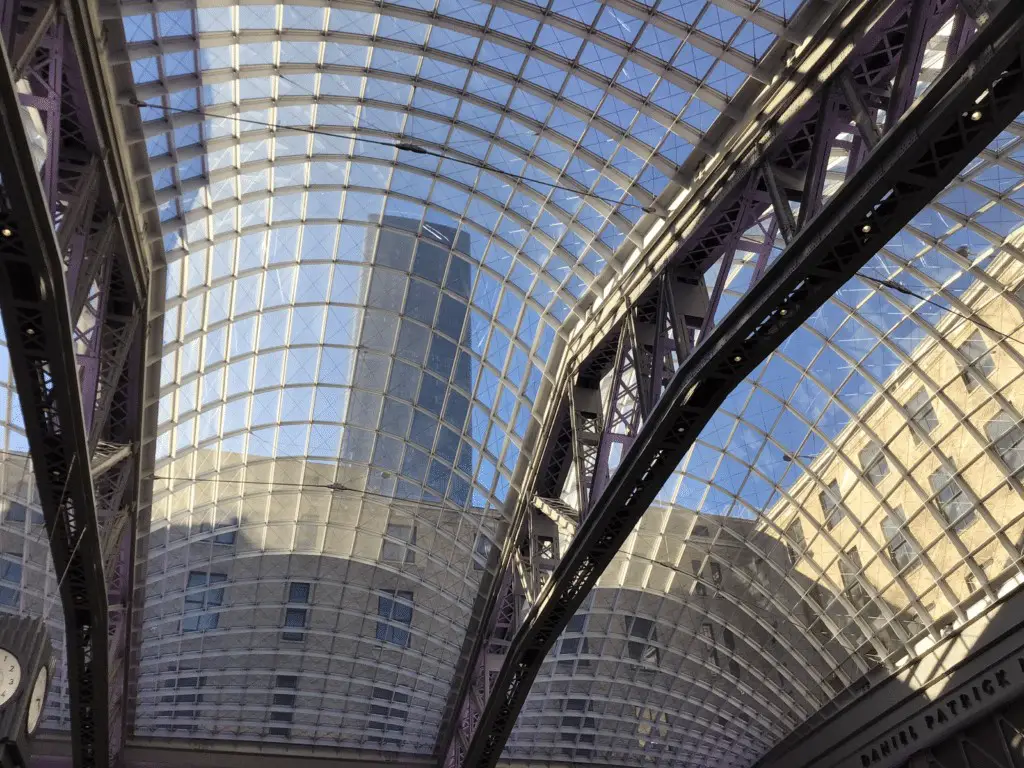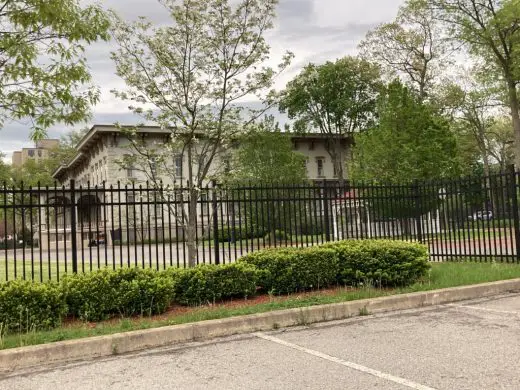Moynihan Train Hall New York Building, SOM NYC Architecture Photos
In the age of the coronavirus, remembering the New York City architecture of my youth
post updated March 24, 2024
In the age of the coronavirus, remembering the New York City architecture of my youth Joel Solkoff’s Column Vol. VII, Number 3.
Thursday May 6, 2021. Rural Williamsport, Pennsylvania, US, population 28,186. {New York City’s population 8.4 million. Distance between them 192 miles}
US Office e-architect – 800 West Fourth Street, Williamsport, Pennsylvania 17701, USA – Today’s column describes a one-day trip I took took on a battery-powered wheelchair on Tuesday February 16th from a nursing home in the New York City Borough of Queens where– the day before– I received the second dose of the Pfizer vacinne to a cab to Manhattan’s glorious new Moynihan Train Hall. Then, after a lenthy train ride to Harrisburg, Pennsylvania’s capitol city, a one hour and 20 minute automobile ride to home. To Williamsport, my home. Now the new U.S. office of e-architect.com
Jan 9 & 6, 2021
Moynihan Train Hall New York City
On the surface, there might not seem to be a parallel between a huge new train station in the largest city in the US and a luxury hotel in a little town in north central Pennsylvania. But for 1863 and the richest man in the world Peter Herdic.
Peter Herdic built a $250 thousand luxury hotel where e-architect now has our US office. The $250 thousand Herdic spent is astonishing in current dollars. Williamsport architect Anthony Visco Jr. who helped save the Herdic luxury hotel from extinction in the 1990s told me “This was a time when a single family home cost $500.”
In 1863, the unwritten rule when building a luxury hotel in the middle of nowhere designed to attract rich Edith Wharton-style rich folks from New York City is to have a train station in your back yard. That is what Herdic did.
Herdic arranged for the Pennsylvania Railroad to construct an elegant train station next to the five acre hotel and sculptured grounds.The rich flocked here from New York City in a gloroius ride on their private elegant railroad cars.
e-architect’s office is now on the ground floor where large urns supplied railroad workers with coffee. From the window, I see Anthony Visco Jr.’s design for a Victorian train station complex now an historical landmark. The Peter Herdic Transportation Museum. Behind the station is a railroad car used by one of the 19th Century rich.
Because of the US’s post World War II assault on passenger train service begun in the 1950s and 1960s by autombile advocates, Williamsport no longer has passenger service. This railroad car sits outside our window going nowhere.
Abandoned railroad car in Williamsport Pennsylvania USA:
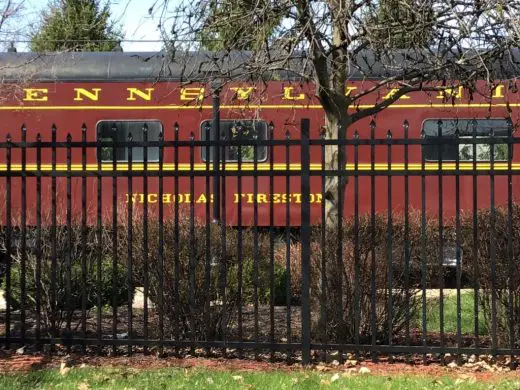
photo © Joel Solkoff
New York City’s 1963 shameful attack on train service
In the 1960s and 1970s, the powerful New York City urban planner Robert Moses played a significant role in creating a destructive automobiles at any price society which we find ourselves in today at our peril. Robert Caro, the Pultizer Prize historian known best for his landmark series on President Lyndon Baines Johnson wrote a biography of Robert Moses. Wikipedia: “After working for many years as a reporter, Caro wrote The Power Broker(1974), a biography of New York urban planner Robert Moses, which was chosen by the Modern Library as one of the hundred greatest nonfiction books of the twentieth century.”
In 1963 as part of an especially shameful act, the New York powers that be began the complete demolition of McKim Mead & White’s astonishingly beautiful 1914 train station shown here:
1914 New York City Penn Station building interior:
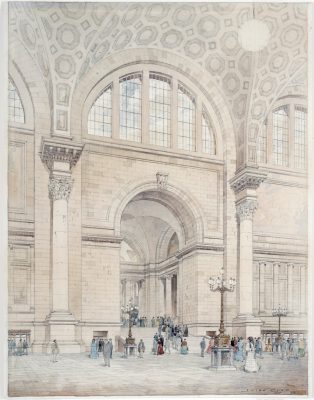
McKim Mead &White’s much admired 1914 New York City Penn Station.
Photo courtesy McKim Mead & White Collection New York Historical Society
The New York Historical Society observed, “Unfortunately, the Pennsylvania Railroad optioned the air rights for the station in the 1950s, which meant the above ground portions of the structure would be demolished to make room for an office and sports complex. Many New Yorkers and architecture fans were outraged, but in 1963 the building was demolished.”
In October of 1963, the New York Times published the following:
“Any city gets what it admires, will pay for, and, ultimately, deserves. Even when we had Penn Station, we couldn’t afford to keep it clean. We want and deserve tin-can architecture in a tinhorn culture. And we will probably be judged not by the monuments we build but by those we have destroyed.”
My disability perspective
I am a paraplegic. During the past 25 years, I have gotten around on a battery-powered wheelchair. A scooter. In future columns I will be describing in detail how the scooter (and indeed the mobility device class) has become a critical architectural tool. It would be best when designing for the disabled, for the the architect to ride around in a scooter.
++++
Moynihan Train Hall building:
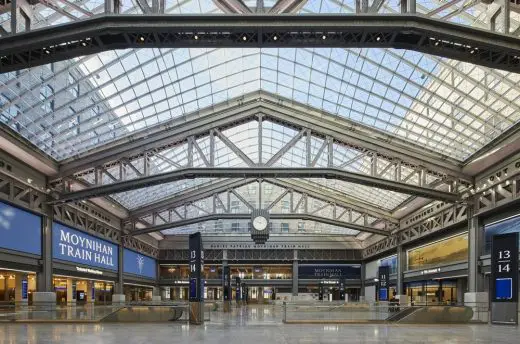
photo : Lucas Blair Simpson © SOM
The difference bertween great architecture and appreicating it in an excellent photograph ilike this one is hard to define. Define magic. If you want magic, nothing can delight like visiting in person as I did this beautifully designed architectural achievement. This waiting room had been the location of the automatic mail sorting machines for what was then the City’s postal headquarters.
Turns out that back in 1982, when I was speechwriter to President Ronald Reagan’s excellent Postmaster General Preston Robert Tisch that I visited the sorting machines here. That was before mail volume dropped dramatically and the Farley Post Office provided New York with the opportunity, as the Moynihan Train Hall has done, to make up for the sin of demolishing the McKim Mead & White Penn Station.
Lucas Blair Simpson © Skidmore Owings and Merrill (SOM). For permission to publish, thank you Clarissa Sorenson, public relations SOM
New York City’s new train station is wonderful
Check you have proof you were vaccinated for the coronavirus, book a flight to LaGuardia ( if you are lucky; Kennedy if not). Both airports are in the Borough of Queens (a too often neglected New York City borough which architects might bnefit from a visit).
Take a cab across Queens to the Moynihan Train Hall, the largest train station in the Western Hemisphere, located in mid-town Manhattan between Eighth and Ninth Avenues; 31st and 33rd Streets. Down the street is the Empire State Building, now beautifully restored by Frank Prial, Jr. at Beyer Blinder Belle. In the 1950s my father had a shabby office at the decaying Empire State Building.
The Moynihan Train Hall is located in this building the James A. Farley Post Office. Farley was President Franklin D Roosevelt (FDR) Postmaster General back in the Depression when it was an extremely powerful position. Wikipedia: “The James A. Farley Building is a mixed-use structure [in addition to the Moynihan Train Hall the building includes what is now a very reduced-size post office] in Midtown Manhattan, New York City, which formerly served as the city’s main United States Postal Service (USPS) branch. Designed by McKim, Mead & White in the Beaux-Arts style, the structure was built between 1911 and 1914, with an annex constructed between 1932 and 1935. The Farley Building…faces Pennsylvania Station and Madison Square Garden to the east.”
James A. Farley Building, New York City:
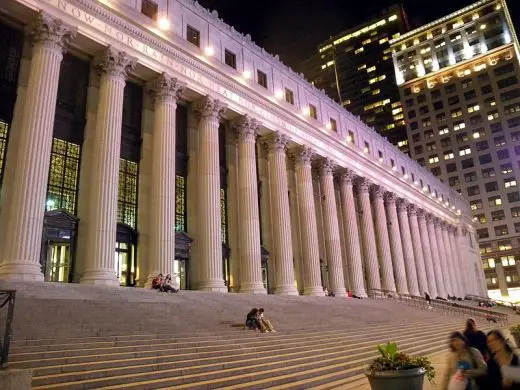
photo courtesy Wikipedia – A. Farley Building – Wikipedia
Naming a glorious McKim, Mead & White Beaux Art gem after Farley appropriately honors both the architecture firm and Farley. Now the building is appropriately renamed after one of the most intriguing and important political figures in the post World War II US. More on Moynihan and architecture in future columns.
Moynihan was extremely friendly to architects. When he worked as a political appointee in President John Kennedy’s administration, Moynihan convinced President Kennedy to sign an executive order to give non-traditional architects (I.e.you my readers) the ability to design to end too often drab federal office buildings
US Ambassador to the UN Daniel Patrick Moynihan (left) speaks with NBC News reporter Edwin Newman in 1975 for the TV special Hard Choices: American Foreign Policy 1976, photo taken 12 December 1975:
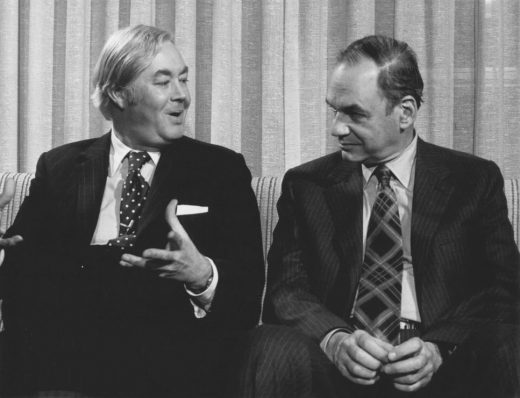
photo : NBC News, Public domain, via Wikimedia Commons
“Daniel Patrick “Pat” Moynihan (March 16, 1927 – March 26, 2003) was an American politician, sociologist, and diplomat. A member of the Democratic Party, he represented New York in the United States Senate and served as an adviser to Republican U.S. President Richard Nixon.”
Amtrak, the US’s provider of passenger train service, writes about Moynihan being the visionary who 25 years ago suggested that this be done.After Moynihan’s death, the late senator’s fascinating daughter Maura worked tirelessly to make her father’s vision real. One architect in a position to know asserted Maura’s contribution to the hall was critical.
”Welcome to Moynihan Train Hall. Amtrak and LIRR [the Long Island Rail Road] have a new home in New York City. A visionary project – a generation in the making – championed by Governor Andrew M. Cuomo, Moynihan Train Hall is the city’s newest grand civic icon. The $1.6 billion project transforms the 100+ year-old James A. Farley Post Office Building into a modern, world-class transit hub – an idea first proposed by the late United States Senator Daniel Patrick Moynihan more than a quarter-century ago.”
++++
My visit to the Moynihan Train Hall returned me to the neighborhood I have known since I was three years old
One of my earliest memories is seeing at age three the McKim Mead & White 1914 Penn Station in the same location as the architectural abomination that is the 1963 Penn Station today. [Curiously, Penn Station, across the street from Moynihan Train Hall continues—as has been the case since the 1960s—to provide access to trains accessible only underground. Penn Station has no waiting room where passengers can see the light of day. Wheel chair access is dreadful. Penn Station should be shut down.]
In 1950 my mother took me to Florida, then a divorce capital, by train. I wanted to live with my father, not my mother.My memory, reinforced by summer train rides from Miami to see Dad in wonderful New York–a joy to visit in the 1950s and early 1960s–,-is of the station waiting room and the view of beautiful light from the City outside.
The Moynihan Train Hall re-captures that memory. This is the photograph I took of the Moynihan waiting room on February 16th after arriving directly by cab from the Regal Heights Nursing Home in Queens where I was a patient for three weeks:
Moynihan Train Hall building New York City:
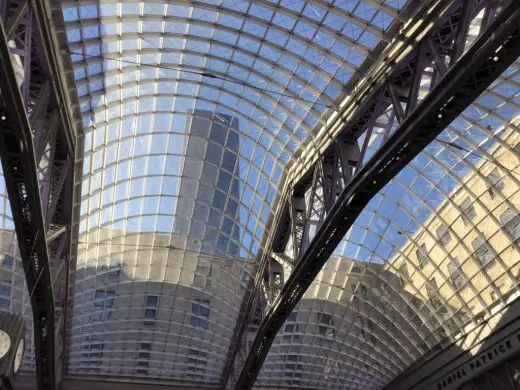
photo © Joel Solkoff
Used a battery powered wheelchair to visit the Moynihan Train Hall
As a 73-year old paraplegic for 25 years, I have been able to get from here to there and back using a battery powered wheelchair (scooter). My scooter has a 20 plus mile range before a charge is required. This means I can go– or so it seems– nearly anywhere on a single charge. During my six weeks in New York first at Memorial Sloan Kettring Center (which should have but doesn’t bathrooms accessible to the disabled) and the nursing home, I used the Amigo Travel Scooter (built in Michigan) for locomotion.
Your columnist at the Regal Heights Nursing Home in Queens on the day that I was released to a cab that took me to The Moynihan Train Hall:

photo by a member of the nursing home staff who gave me permission to use
This is what the collapsible scooter looked like when I drove it from nursing home to cab:
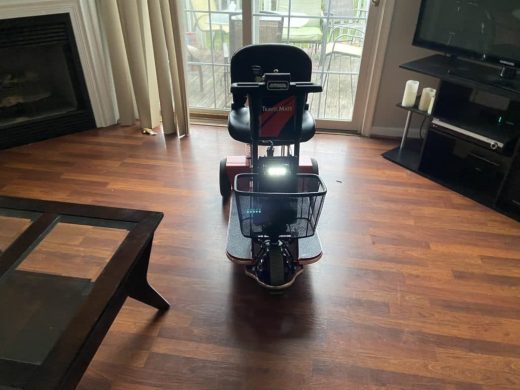
photo by Frank Rasole, Jr., my excellent health aide and assistant
This is what the collapsed scooter looked like when the taxi driver arrived at the Moynihan Train Hall and removed it from his trunk
This is the inaccessible entrance at one end of the Moynihan Train Hall I feared. Beautiful isn’t it?
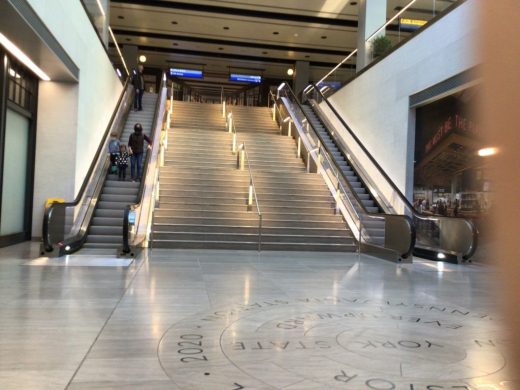
photo © Joel Solkoff
This is the excellent grand wheelchair friendly entrance at the othher end of the Moynihan Train Hall I never dreamed possible:
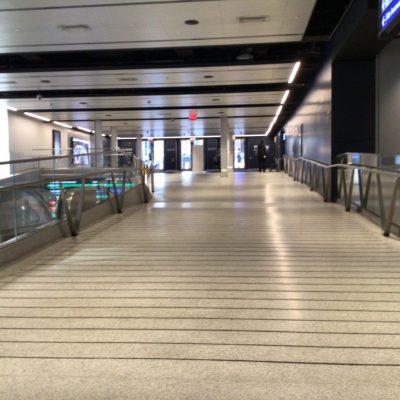
photo © Joel Solkoff
Once again this is the entrance from the taxi to the train station—riding upon a network of hidden ramps that made it possible for me to ride directly from the cab to the waiting room of Moynihan Train Hall:

photo © Joel Solkoff
Joel’s Column will return with more on the Moynihan Train Hall & SOM, the firm that brilliantly designed it
Global architects note: Infrastructure reform will help your bottom line
Infrastructure reform, after decades of neglect, is likely to take place and provide architects with commissions. President Biden’s bill would cost $2.2 trillion. The President’s approach expands the definition of infrastructure to include, for example, $300 billion for public housing and the necessity to upgrade housing so it is disability friendly.
The Republican version would narrow the definition of infrastructure to roads, trains, planes and wi/fi at a cost of $900 billion. My member of Congress Republican Rep.Fred Keller is a sponsor.
Whichever bill passes, Williamsport in isolated Lycoming County, the physically largest county in the state, requires passenger train service. As with so much of the country train service would open up our community to economic expansion. Here in a town with a large percntage of low income elderly. it would provide us with access to health care still badly needed to control the pandemic.
Sounding often like an urban planner, here is Secretary of Transportation Peter Buttigieg who has become the Administration’s leader for its expanded infrastructue plan:
Embedded under terms of YouTube’s licensing agreement
My editors beckon: “All right, stop writing, Joel.”
Isabelle Lomholt and Adrian Welch, Editors at e-architect:
One last look before I leave. Plus here is our editor Isabelle’s report when the Moynihan Train Hall opened January 5, 2021
“Designed by SOM, the Moynihan Train Hall completely reimagines the travel experience at the busiest transportation hub in the Western Hemisphere, and evokes the architectural heritage of New York’s original Pennsylvania Station.”
In the age of the coronavirus, remembering the New York City architecture of my youth article from Joel Solkoff
Copyright © 2021 by Joel Solkoff. All rights reserved.
— Joel Solkoff, US Editor, e-architect, Williamsport, Pennsylvania USA
Moynihan Train Hall
Architects: SOM
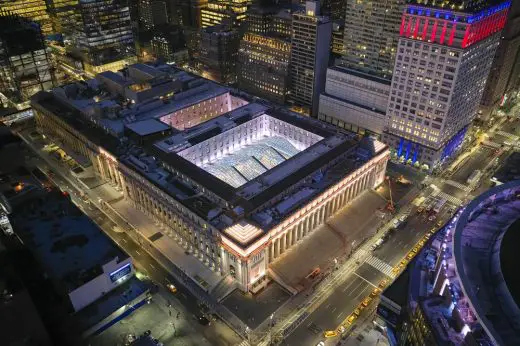
photo © Lucas Blair Simpson | Aaron Fedor © SOM
Moynihan Train Hall
Location: New York City, USA
New York City Architecture
Contemporary New York Buildings
Manhattan Architectural Designs – chronological list
New York City Architecture Tours by e-architect
Il Makiage pavilion
Design: Zaha Hadid Architects
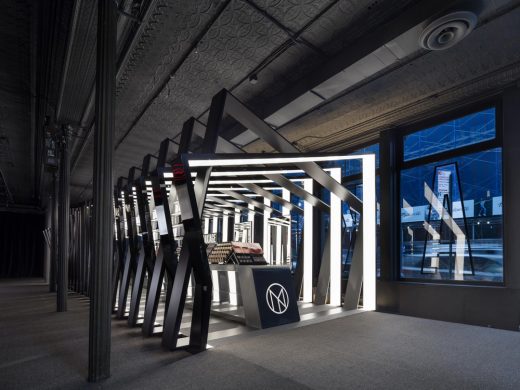
photograph : Paul Warchol
Il Makiage pavilion by Zaha Hadid
45 Park Place, Tribeca, Lower Manhattan
Design: SOMA Architects ; AOR: Ismael Leyva
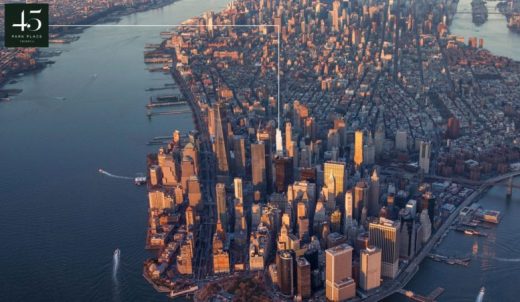
rendering : Williams New York
45 Park Place Tower
432 Park Avenue Skyscraper
Design: Rafael Viñoly Architects
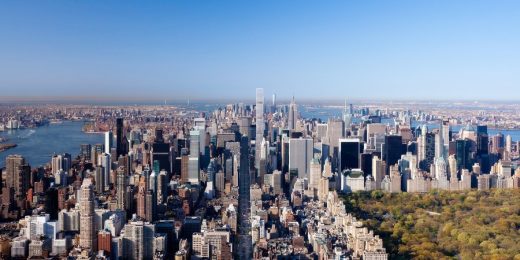
image © dbox for CIM Group & Macklowe Properties
432 Park Avenue Tower New York
Comments for the Remembering New York City architecture of my youth page welcome

